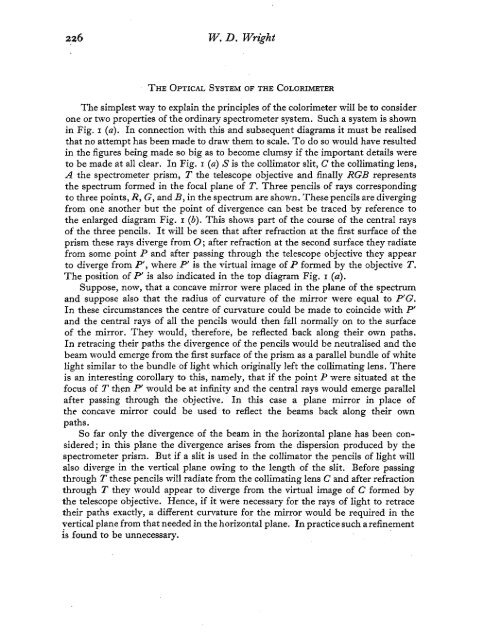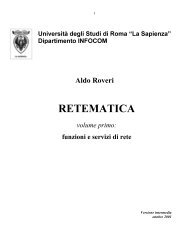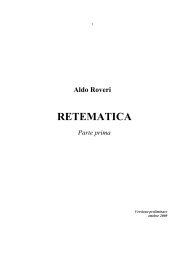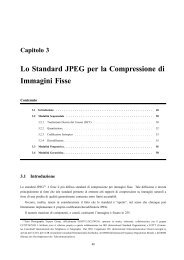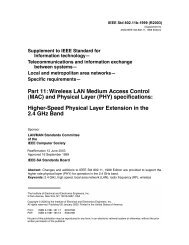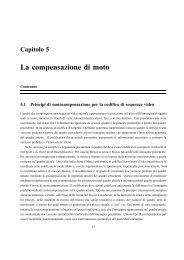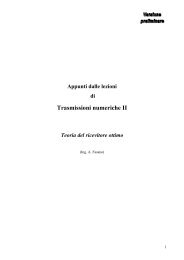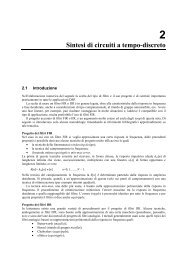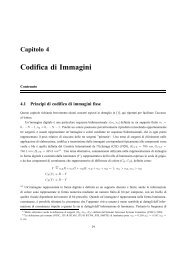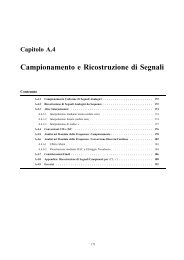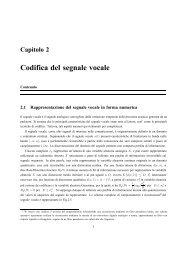a trichromatic colorimeter with spectral primaries - InfoCom
a trichromatic colorimeter with spectral primaries - InfoCom
a trichromatic colorimeter with spectral primaries - InfoCom
Create successful ePaper yourself
Turn your PDF publications into a flip-book with our unique Google optimized e-Paper software.
226<br />
THE OPTICAL SYSTEM OF THE COLORIMETER<br />
The simplest way to explain the principles of the <strong>colorimeter</strong> will be to consider<br />
one or two properties of the ordinary spectrometer system. Such a system is shown<br />
in Fig. I (a). In connection <strong>with</strong> this and subsequent diagrams it must be realised<br />
that no attempt has been made to draw them to scale. To do so would have resulted<br />
in the figures being made so big as to become clumsy if the important details were<br />
to be made at all clear. In Fig. I (U) S is the collimator slit, C the collimating lens,<br />
A the spectrometer prism, T the telescope objective and finally RGB represents<br />
the spectrum formed in the focal plane of T. Three pencils of rays corresponding<br />
to three points, R, G, and B, in the spectrum are shown. These pencils are diverging<br />
from one another but the point of divergence can best be traced by reference to<br />
the enlarged diagram Fig. I (b). This shows part of the course of the central rays<br />
of the three pencils. It will be seen that after refraction at the first surface of the<br />
prism these rays diverge from 0; after refraction at the second surface they radiate<br />
from some point P and after passing through the telescope objective they appear<br />
to diverge from P', where P' is the virtual image of P formed by the objective T.<br />
The position of P' is also indicated in the top diagram Fig. I (a).<br />
Suppose, now, that a concave mirror were placed in the plane of the spectrum<br />
and suppose also that the radius of curvature of the mirror were equal to PIG.<br />
In these circumstances the centre of curvature could be made to coincide <strong>with</strong> P'<br />
and the central rays of all the pencils would then fall normally on to the surface<br />
of the mirror. They would, therefore, be reflected back along their own paths.<br />
In retracing their paths the divergence of the pencils would be neutralised and the<br />
beam would emerge from the first surface of the prism as a parallel bundle of white<br />
light similar to the bundle of light which originally left the collimating lens. There<br />
is an interesting corollary to this, namely, that if the point P were situated at the<br />
focus of T then P' would be at infinity and the central rays would emerge parallel<br />
after passing through the objective. In this case a plane mirror in place of<br />
the concave mirror could be used to reflect the beams back along their own<br />
paths.<br />
So far only the divergence of the beam in the horizontal plane has been con-<br />
sidered ; in this plane the divergence arises from the dispersion produced by the<br />
spectrometer prism. But if a slit is used in the collimator the pencils of light will<br />
also diverge in the vertical plane owing to the length of the slit. Before passing<br />
through T these pencils will radiate from the collimating lens C and after refraction<br />
through T they would appear to diverge from the virtual image of C formed by<br />
the telescope objective. Hence, if it were necessary for the rays of light to retrace<br />
their paths exactly, a different curvature for the mirror would be required in the<br />
vertical plane from that needed in the horizontal plane. In practice such arefinement<br />
is found to be unnecessary.


